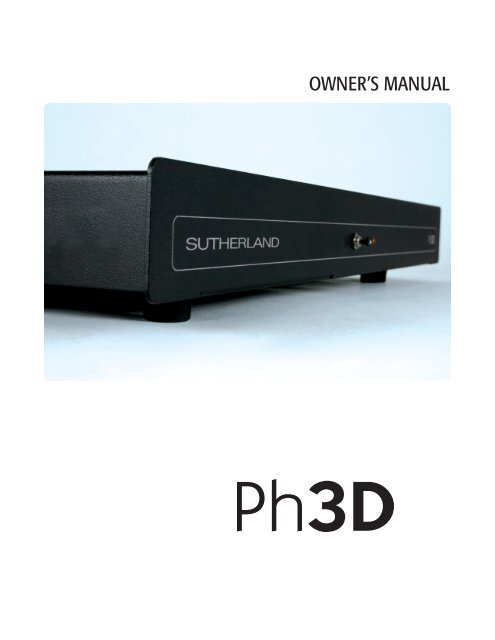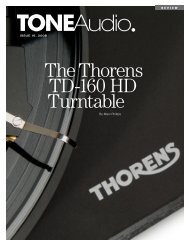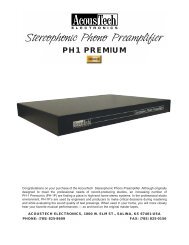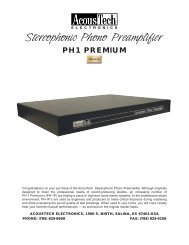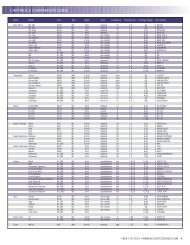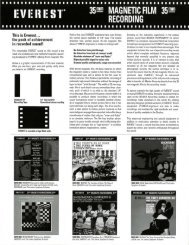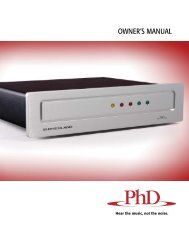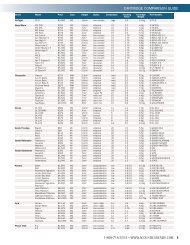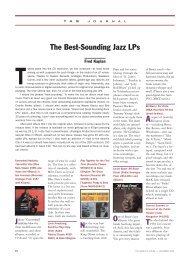OWNER'S MANUAL - Acoustic Sounds
OWNER'S MANUAL - Acoustic Sounds
OWNER'S MANUAL - Acoustic Sounds
Create successful ePaper yourself
Turn your PDF publications into a flip-book with our unique Google optimized e-Paper software.
OWNER’S <strong>MANUAL</strong>
YOUR SUTHERLAND Ph3D<br />
A note from designer RON SUTHERLAND:<br />
Thank you for choosing the Ph3D for your<br />
listening system. If you are the kind of<br />
person that sees aesthetic beauty in simplicity<br />
and no-frills functionality, you are<br />
going to appreciate the design choices of<br />
this unit. The Ph3D is a slice of the Ph.D<br />
and a slice of the PH-1P, two of my earlier<br />
phono preamp designs. Each slice was<br />
carefully chosen to deliver the essence<br />
of true high-end performance in an<br />
an innovative package. Enjoy the elegance<br />
of the Ph3D. But most importantly,<br />
enjoy how it sings in your system.<br />
Happy listening,<br />
Ron<br />
A brief look at just some of the Ph3D's features:<br />
• Complete isolation from the noisy AC power line<br />
• No chasing down elusive ground loops<br />
• Easy-to-find, easy-to-buy, easy-to-replace D-cell battery<br />
power supply<br />
• Low-battery indicator light<br />
• Built-to-last, cold-roll steel with baked-on epoxy powder<br />
coating<br />
• Complete electrostatic and magnetic shielding<br />
• Easy internal access with stainless steel thumbscrews<br />
• Convenient selection of five cartridge-loading values<br />
• Convenient selection of five gain settings<br />
• Configured with gold-plated headers and shunts<br />
• High contact pressure, large contact surface<br />
• No cheap DIP rocker switches<br />
• Audiophile grade components, including Wima<br />
polypropylene/film capacitors, Dale/Vishay CCF-55<br />
metal film resistors, double-sided FR-4 fiberglass circuit<br />
board, gold-plated RCA jacks and gold-plated configuration<br />
setting<br />
• Dual mono circuit board layout for best channel<br />
separation (You get exactly the same layout for each<br />
channel – check out the photos)<br />
Design Philosophy<br />
An amplifier does not make the input signal "bigger."<br />
Instead, it uses the input signal to control the delivery of<br />
power from a power supply. So the increased size of the<br />
output signal comes entirely from the power supply. The<br />
quality and purity of the power supply is an essential<br />
foundation for creating a high-quality output signal. Still,<br />
in many designs, the power supply is given only casual<br />
consideration.<br />
Consider that one of the noisiest components in your<br />
home stereo is the incoming AC power. Even if it were<br />
delivered to your home as an idealized 60 Hz sine wave,<br />
it would not stay that way long. One of the biggest polluters<br />
is the audio power amplifier. It does not draw current<br />
from the power line evenly. There is a large current<br />
spike drawn when the sine wave reaches its voltage<br />
extremes, while at other times current draw is essentially<br />
zero. High-frequency harmonics and noise are introduced<br />
into the same power line used for sensitive phono preamplification.<br />
There are, of course, many other factors<br />
that contribute to power line distortion and noise.<br />
While several preamplifier designs have aimed to isolate<br />
the AC power line with varying degrees of success, ultimate<br />
power supply purity cannot be achieved without<br />
absolute elimination of the AC power line. In the case of<br />
the Sutherland Ph3D, there is no connection to the AC<br />
power line at all – period. Instead, the power for the<br />
Ph3D is 16 alkaline D cells. In this application, the batteries<br />
have a useable lifetime of 1,200 operating hours.<br />
As they age, low-power supply impedance is maintained<br />
by high-value storage capacitance. And unlike designs<br />
that use rechargeable batteries, the Ph3D is not compromised<br />
and encumbered with battery-charging circuitry. In<br />
fact, one of the surprising features of the Ph3D is the<br />
absence of ANY power connections on the back panel. It<br />
is totally isolated from any outside power noise.<br />
Unlike the much more expensive Ph.D., the Ph3D does<br />
not have automatic power management. Power is controlled<br />
the old-fashioned way, with a manual toggle<br />
switch. However, if you remember to turn off your Ph3D<br />
after each listening session, you'll enjoy about 1,200<br />
hours of effective use before having to change the batteries,<br />
which is a simple process.<br />
In designing the Ph3D, Sutherland concentrated on eliminating<br />
needless power consumption. So as very little<br />
power is used, very little heat is generated within the<br />
components. There is essentially no temperature rise<br />
and no need for "warm-up" time. The design also has<br />
very little or no DC voltage across the signal-carrying<br />
capacitors, so that dielectric forming is not an issue.
INDICATORS<br />
The red front panel LED indicates power on. As the<br />
battery voltage decreases with usage, it will get dimmer.<br />
When the voltage gets low enough that performance<br />
is compromised, the LED will go out abruptly.<br />
CONFIGURATION<br />
Conventional designs use inexpensive, low-quality<br />
computer rocker switches. Their design is<br />
inadequate for configuring the low-level signal<br />
from a phono cartridge. To offer the user a wide<br />
range of configurations while maintaining signal<br />
integrity, the Ph3D uses gold-plated header pins<br />
and gold-plated shunts. They offer high-pressure<br />
and large surface area contacts.<br />
Each channel has two configuration headers:<br />
One to select cartridge loading and another to<br />
select gain. When changing configuration, be<br />
sure to set each channel to the same value.<br />
Options are printed directly on the circuit board<br />
next to the configuration headers.<br />
GAIN ADJUSTMENT<br />
There are five available gain settings. Gain is<br />
set using the supplied, gold-plated shunts.<br />
There is a gain setting header block for<br />
each channel. Position the shunt to the<br />
desired gain value. Be sure to set the gain<br />
of each channel to the same value.<br />
CARTRIDGE LOADING ADJUSTMENT<br />
There are five available loading settings. Loading is set<br />
using the supplied, gold-plated shunts. There is a load<br />
setting header block for each channel. Position the<br />
shunt to the desired loading value. Be sure to set the<br />
loading of each channel to the same value.<br />
BATTERIES<br />
Your Ph3D is powered by 16 D-cell alkaline batteries. They<br />
have a nominal useful life in this application of about<br />
1,200 hours. The front panel red LED functions as both a<br />
Power-ON indicator and a battery condition indicator. As<br />
the batteries discharge, their voltage will decrease. When<br />
the voltage has decreased to a level that will impair the<br />
performance of the Ph3D, the LED will not illuminate, and<br />
it is time to replace the batteries.<br />
It is recommended that the batteries be replaced when<br />
either the LED does not illuminate or once a year, whichever<br />
occurs first. Replace all batteries at the same time with<br />
all batteries of the same type.<br />
The negative battery is placed facing the springs. If batteries<br />
are installed incorrectly, protection circuitry will prevent<br />
any damage to your Ph3D's circuitry.<br />
The red front panel LED indicates power on.<br />
Supplied loading values:<br />
• 100 ohms<br />
• 200 ohms<br />
• 1k ohms<br />
• 10k ohms<br />
• 47k ohms<br />
Supplied gain values:<br />
• 40 dB<br />
• 45 dB<br />
• 50 dB<br />
• 55 dB<br />
• 60 dB<br />
Your Ph3D is powered by 16 D-cell alkaline batteries.<br />
The rear panel includes inputs, outputs and a ground lug.
Ph3D SPECIFICATIONS<br />
Gain Settings<br />
40 dB<br />
45 dB<br />
50 dB<br />
55 dB<br />
60 dB<br />
Cartridge Loading<br />
100 ohms<br />
200 ohms<br />
1k ohms<br />
10k ohms<br />
47k ohms<br />
Size<br />
17” wide<br />
2” high<br />
12” deep<br />
Weight (without batteries installed)<br />
9 lbs. net<br />
12 lbs. shipping<br />
Power Requirements<br />
16 Alkaline ‘D’ cells<br />
Battery Life<br />
1,200 hours<br />
(actual power-on time)<br />
Sutherland Engineering products, like those of AcousTech Electronics,<br />
are designed by Ron Sutherland for exclusive distribution through 2 Channel Distribution<br />
1500 S. Ninth, Suite B, Salina, Kansas 67402<br />
785.820.2931 • Fax 785.825.0156 • www.2channeldistribution.com


